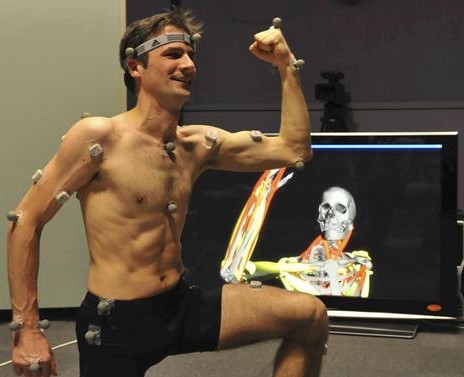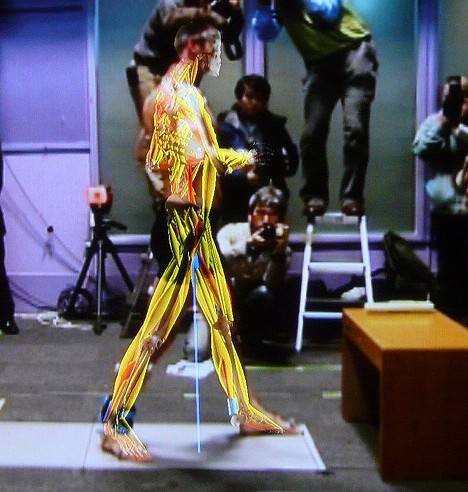
Researchers at the University of Tokyo have developed a computerized, sensor-based "magic mirror" that analyzes muscular activity and shows real-time computer-generated images of how hard the user's muscles are being worked while exercising.
The magic mirror, developed under the leadership of professor Yoshihiko Nakamura of the Information and Robot Technology Research Initiative (IRT), was unveiled at the University of Tokyo last Friday. In a demonstration for the media, the system's display monitor showed a real-time computer-generated image of a male model's musculo-skeletal system while he performed a series of physical exercises.
The system, which is currently capable of monitoring the activity of 30% of the body's roughly 300 skeletal muscle pairs, consists of 16 electromyographs (instruments that record the electrical waves associated with muscle activity) attached to the user's body, 10 motion-capture cameras, and a pair of floor sensors to measure the force exerted on the legs.
On the monitor, each muscle is shown in a different color depending on how much it is being used at a particular moment. Active muscles are shown in red, while inactive muscles are shown in yellow.

(Muscle images can also be overlaid on the video image of the user's body.)
The magic mirror system uses newly developed software that is reportedly 10 times faster than previous technology, allowing the system to operate in real-time, even when the user is moving rapidly.
The researchers, who are already working on a more compact version that incorporates the cameras directly into the display, envision the system being used in homes, gyms and hospitals. In addition to helping people get into shape, the system might also help doctors more effectively treat conditions that affect the muscles.
[Sources: Robot Watch, Yomiuri, Nikkei]

Stephen Kember
Great, utterly fascinating. This sort of work needs to be supported at every level given the levels of obesity and the lack of exercise taken by people at all levels in our society; who knows where this stream of technology could take us.
Its telling that again such leading edge technology is coming from Japan; I trust that in Europe and the USA the same highly focused creative technologies are leading to projects that have a real impact on the physical health of our nation.
Stephen Kember
[]Mjx
Fascinating stuff, but something is wrong with the information: there are well over 600 skeletal muscles in the human body; you can easily check this by looking pretty much anyplace, including 'muscles', of wikipedia.
M.
[]